| Xanthorrhoea | |
|---|---|
 | |
| X. semiplana | |
| Scientific classification | |
| Kingdom: | Plantae |
| Clade: | Tracheophytes |
| Clade: | Angiosperms |
| Clade: | Monocots |
| Order: | Asparagales |
| Family: | Asphodelaceae |
| Subfamily: | Xanthorrhoeoideae |
| Genus: | Xanthorrhoea Sol. ex Sm. |
| Species | |
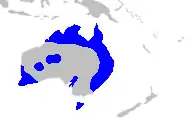 | |
| Distribution of Xanthorrhoea | |
| Synonyms[1] | |
|
Acoroides Sol. ex Kite, not validly published | |
Xanthorrhoea (/zænθoʊˈriːə/[2]) is a genus of about 30 species of flowering plants, in the family Asphodelaceae. They are endemic to Australia.
Description
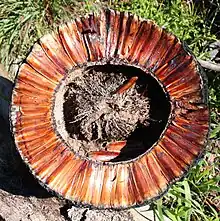
All species in the genus are perennials and have a secondary thickening meristem in the stem. Many, but not all, species develop an above ground stem. The stem may take up to twenty years to emerge. Plants begin as a crown of rigid grass-like leaves, the caudex slowly growing beneath. The main stem or branches continue to develop beneath the crown. This is rough-surfaced, built from accumulated leaf-bases around the secondarily thickened trunk. The trunk is sometimes unbranched, some species will branch if the growing point is damaged, and others naturally grow numerous branches.[3][4]
Flowers are borne on a long spike above a bare section called a scape; the total length can be over three to four metres long in some species.[4] Flowering occurs in a distinct period, which varies for each species, and often stimulated by bushfire. Fires will burn the leaves and blacken the trunk, but the plant survives as the dead leaves around the stem serve as insulation against the heat of a wildfire.
The rate of growth of Xanthorrhoea is slow. Some species grow slowly (0.8–6 cm in height per year), but increase their rate of growth in response to season and rainfall. After the initial establishment phase, the rate of growth varies widely from species to species. Thus, while a five-metre-tall member of the fastest-growing Xanthorrhoea may be 200 years old, a member of a more slowly growing species of equal height may have aged to 600 years.[5][4]
Taxonomy
Xanthorrhoea is allied to the family Asphodelaceae as monotypic subfamily Xanthorrhoeoideae.[1] The Xanthorrhoeoideae are monocots, part of order Asparagales.[6]
A reference to its yellow resin,[2] Xanthorrhoea literally means "yellow flow" in Ancient Greek. Smith named it in 1798,[7] from xanthos (‘yellow, golden’) and rhœa (‘flowing, flow’).[2] The invalid Acoroides (‘Acorus-like’[8]) was a temporary designation in Solander's manuscript from his voyage with Cook, originally not meant for publication.[7]
Common names for Xanthorrhoea include grasstree, grass gum-tree (for its resin-yielding species),[2] kangaroo tail[9] and blackboy.[10]
In the South West, the Noongar name balga' is used for X. preissii. In South Australia, Xanthorrhoea is commonly known as yakka, also spelled yacca and yacka, a name probably from a South Australian Aboriginal language,[11] mostly likely Kaurna.
The name grasstree is applied to many other plants.
Kingia and Dasypogon are unrelated Australian plants with a similar growth habit to Xanthorrhoea. Both genera have at times been confused with xanthorrhoeas and misnamed as "grasstrees". Some plant classification systems such as Cronquist[12] have included a wide range of other genera in the same family as Xanthorrhoea. However, later anatomical and phylogenetic research has supported the view of Dahlgren[13] who regarded Xanthorrhoea as the sole member of his family Xanthorrhoeaceae sensu stricto, which is now treated as the subfamily Xanthorrhoeoideae.[14]
Diversity and distribution

The genus is endemic to Australia, occurring in all national states and territories. Some species have a restricted range, others are widely distributed. According to the World Checklist of Selected Plant Families, as of September 2014 the following species are accepted:[1]
| Image | Name | Authority | States and Territories | ||||||
|---|---|---|---|---|---|---|---|---|---|
| NSW | QLD | VIC | TAS | SA | WA | NT | |||
 |
X. acanthostachya | D.J.Bedford | · | · | · | · | · | Y | · |
| X. acaulis | (A.T.Lee) D.J.Bedford | Y | · | · | · | · | · | · | |
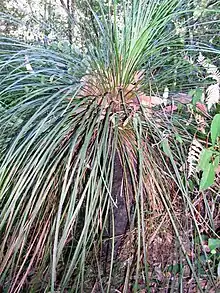 |
X. arborea | R.Br. | Y | · | · | · | · | · | · |
| X. arenaria | D.J.Bedford | · | · | · | Y | · | · | · | |
.JPG.webp) |
X. australis | R.Br. | Y | · | Y | Y | Y | · | · |
| X. bracteata | R.Br. | · | · | · | Y | · | · | · | |
| X. brevistyla | D.A.Herb. | · | · | · | · | · | Y | · | |
 |
X. brunonis | Endl. in J.G.C.Lehmann | · | · | · | · | · | Y | · |
 |
X. caespitosa | D.J.Bedford | · | · | · | · | Y | · | · |
 |
X. concava | (A.T.Lee) D.J.Bedford | Y | · | · | · | · | · | · |
 |
X. drummondii | Harv. | · | · | · | · | · | Y | · |
 |
X. fulva | (A.T.Lee) D.J.Bedford | Y | Y | · | · | · | · | · |
 |
X. glauca | D.J.Bedford | Y | Y | Y | · | · | · | · |
 |
X. gracilis | Endl. in J.G.C.Lehmann | · | · | · | · | · | Y | · |
 |
X. johnsonii | A.T.Lee | Y | Y | · | · | · | · | · |
 |
X. latifolia | (A.T.Lee) D.J.Bedford | Y | Y | · | · | · | · | · |
.jpg.webp) |
X. macronema | F.Muell. ex Benth. | Y | Y, Fraser Island | · | · | · | · | · |
 |
X. malacophylla | D.J.Bedford | Y | · | · | · | · | · | · |
 |
X. media | R.Br. | Y | · | · | · | · | · | · |
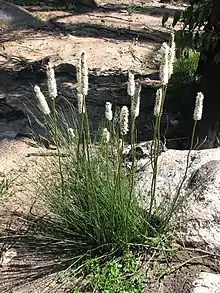 |
X. minor | R.Br. | Y | · | Y | · | Y | · | · |
 |
X. nana | D.A.Herb. | · | · | · | · | · | Y | · |
 |
X. platyphylla | D.J.Bedford | · | · | · | · | · | Y | · |
 |
X. preissii (syn. X. pecoris F.Muell.) | Endl. in J.G.C.Lehmann | · | · | · | · | · | Y | · |
 |
X. pumilio | R.Br. | · | Y | · | · | · | · | · |
 |
X. quadrangulata | F.Muell. | · | · | · | · | Y | · | · |
 |
X. resinosa (syn. X. hastilis) | Pers. | Y | · | Y | · | · | · | · |
 |
X. semiplana | F.Muell. | · | · | Y | · | Y | · | · |
 |
X. thorntonii | Tate | · | · | · | · | Y | Y | Y |
Habitat
Grasstrees grow in coastal heaths, and wet and dry forests of Australia. They are drought and frost tolerant. The grass tree mainly occurs in soils that are very free draining and consequently low in nutrients. It survives in the poorest soils, with a shallow root system, enabling it easily access nutrients from decaying litter, while storing all the food reserves in its stem.[15]
Ecology
The grass tree has developed adaptations that help it better suit the environment where it occurs. If a fire breaks out, the grass tree has a special physiological adaptation called thermal insulation that helps protect the plant. The grass tree holds its thick, dead leaves around its stem which serves as insulation, and helps to protect the plant against the heat of the fire.[16]
They need fire to clear away dead leaves and promote flowering, as these slow-growing trees were among the first flowering plants to evolve.[17] Grass trees have developed a structural adaptation which helps the grass tree take advantage of soil fertilized with ash after fire, producing a flowering stalk in the aftermath.
The grass tree forms a mycorrhizal relationship with fungi deep in its root system, wherein fungi live in a mutually beneficial relationship with the grass tree roots. The fungus increases the tree root's access to water and nutrients and therefore increases tree growth especially in poor conditions. The grass tree also suffers from a condition known as phytophthora dieback. Phytophthora cinnamomi is a discrete soil borne pathogen that attacks and destroys vascular root systems, causing hosts to perish through lack of nutrients and water. It is spread through infected plants and the movement of contaminated soil and gravel.[18] The leaves of the grass tree are hosts to another fungi, Pseudodactylaria xanthorrhoeae.[19]
Cultivation
Xanthorrhoea may be cultivated, as seed is easily collected and germinated. While they do grow slowly, quite attractive plants with short trunks (10 cm) and leaf crowns up to 1.5 m (to the top of the leaves) can be achieved in 10 years. The slow growth rate means that it can take 30 years to achieve a specimen with a significant trunk. Most Xanthorrhoea sold in nurseries are established plants taken from bushland. Nurseries charge high prices for the plants. However, there is a very low survival rate for nursery-purchased plants (mainly due to over watering), which may take several years to die. The most successful examples of transplanting have been where a substantial amount of soil, greater than one cubic metre, has been taken with the plants.
The genus Xanthorrhoea, more commonly known as the grass tree, is an iconic plant that epitomizes the Australian bush in its ability to live in poor nutrient soils and respond to wildfire.[20]
Commonly grown species for the garden include Xanthorrhoea australis, X. malacophylla and X. preissii.[4]
Uses
Xanthorrhoea is important to the Aboriginal peoples. It is a highly valued resource with many uses.[21] The flowering spike may be utilised as the lightweight handle of a composite spear with a hardwood sharp shaft inserted into the end.[22] It is also soaked in water and the nectar from the flowers gives a sweet-tasting drink. In the bush the flowers could reveal directions, since flowers on the warmer, sunnier side – usually north – of the spike often open before the flowers on the cooler side facing away from the sun.[23]
The resin from Xanthorrhoea plants is used in spear-making[24] and is an invaluable adhesive for Aboriginal people, often used to patch up leaky coolamons (water containers) and even yidaki (didgeridoos). The dried flower stalk scape was also used to generate fire by the hand drill friction method.
Resin collected from the plant was used in Australia until the mid-twentieth century for the following purposes:[25]
- Burnt as an incense in churches.
- A base component for a varnish used on furniture and in dwellings.
- A polish and a coating used on metal surfaces including stoves, tin cans used for storing meat and “brass instruments.”
- A component used in industrial processes associated with “sizing paper, in soap making, perfumery and in manufacturing early gramophone records.”
Gallery
 X. australis flower spike, flowering
X. australis flower spike, flowering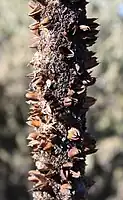 X. preissii flower spike, after fruiting
X. preissii flower spike, after fruiting
References
- 1 2 3 "Xanthorrhoea". World Checklist of Selected Plant Families (WCSP). Royal Botanic Gardens, Kew.
- 1 2 3 4 "xanthorrhoea". Oxford English Dictionary (Online ed.). Oxford University Press. (Subscription or participating institution membership required.) "Bot. (With capital initial.)"
- ↑ "Xanthorrhoea gracilis Endl., in J.G.C.Lehmann, Pl. Preiss 2: 39 (1846)". Flora of Australia Online. Department of the Environment and Heritage, Australian Government.
- 1 2 3 4 Ross, Graham (26 June 1998). Botanica. Milsons Point, N.S.W.: Random House. p. 938. ISBN 9780091837846.
- ↑ "Grass trees". Bush Heritage Australia. Retrieved 4 June 2017.
- ↑ Bedford, David J. (1986). "9. Xanthorrhoea". In George, A. S. (ed.). Flora of Australia: Iridaceae to Dioscoreaceae. Flora of Australia. Vol. 46. Canberra: Australian Govt. Pub. Service. pp. 148–169. ISBN 978-0-644-04356-4. OCLC 715706708. (PDF)
- 1 2 Nelson, E. Charles; Bedford, D.J. (June 1993) [1993]. "The names of the Australian grass-tree: Xanthorrhoea Sm. and Acoroides C. Kite (Xanthorrhoeaceae)". Botanical Journal of the Linnean Society. 112 (2): 95–105. doi:10.1006/bojl.1993.1044. OCLC 664816018. S2CID 91163322.
{{cite journal}}: CS1 maint: date and year (link) ResearchGate Publication 229812945 - ↑ Gledhill, D. (2008) [First published 1985]. The Names of Plants (4th ed.). Cambridge U. Press. p. 35. ISBN 978-0-521-86645-3.
- ↑ "Kangaroo tail". Parks Australia. Retrieved 16 April 2022.
- ↑ "'Blackboy Ridge' nature reserve told to change name due to cultural insensitivity". Australian Broadcasting Corporation. 2 October 2020. Retrieved 16 April 2022.
- ↑ Peters, Pam, The Cambridge Australian English Style Guide, Cambridge University Press, 1996, p823. ISBN 978-0-521-57634-5
- ↑ Cronquist, A.J. An Integrated System of Classification of Flowering Plants, Columbia University Press, New York 1981. ISBN 0231038801
- ↑ Dahlgren, R. M. T. (1980). "A revised system of classification of the angiosperms". Botanical Journal of the Linnean Society. Oxford University Press (OUP). 80 (2): 91–124. doi:10.1111/j.1095-8339.1980.tb01661.x. eISSN 1095-8339. ISSN 0024-4074. OCLC 974317225.
- ↑ Chase, Mark W.; Reveal, James L.; Fay, Michael F. (8 October 2009) [2009]. "A subfamilial classification for the expanded asparagalean families Amaryllidaceae, Asparagaceae and Xanthorrhoeaceae". Botanical Journal of the Linnean Society. 161 (2): 132–136. doi:10.1111/j.1095-8339.2009.00999.x. ISSN 0024-4074. OCLC 460811673. S2CID 83752262. ResearchGate Publication 229700277
- ↑ Flora of Tasmania. Xanthorrhoea Australis [PDF]. Retrieved from http://dpipwe.tas.gov.au/Documents/Xanthorrhoea-australis-Notesheet.pdf Archived 23 March 2016 at the Wayback Machine
- ↑ Petruzzello, M. (2017) Playing with Wildfire: 5 Amazing Adaptations of Pyrophytic Plants. Retrieved from https://www.britannica.com/list/5-amazing-adaptations-of-pyrophytic-plants
- ↑ Ward, D. (2004). Grasstrees show fire history. Australian Geographic, (75),28,
- ↑ Parks Victoria. (2016). Cinnamon Fungus. Retrieved from http://parkweb.vic.gov.au/parkmanagement/environment/weeds-and-pests/cinnamon-fungus%5B%5D
- ↑ Crous PW, Wingfield MJ, Burgess TI, Carnegie AJ, Hardy GE, Smith D, et al. (December 2017). "Fungal Planet description sheets: 625-715". Persoonia. 39 (1): 270–467. doi:10.3767/persoonia.2017.39.11. PMC 5832955. PMID 29503478.
- ↑ Campbell, Colin (25 February 2006). "Grass Tree". Gardening Australia. Australian Broadcasting Corporation. Retrieved 14 August 2018.
- ↑ Hopper, S.; Lambers, H. (2014), "9. Human relationships with and use of Kwongan plants and lands", Plant life on the sandplains in southwest Australia : a global biodiversity hotspot : kwongan matters, Crawley, Western Australia UWA Publishing, pp. 287–90, ISBN 978-1-74258-564-2
- ↑ http://koorihistory.com/grass-tree-resin/ Hard Yakka! Grass Tree Resin (Xanthorrhoea)
- ↑ "Gardening Australia - Fact Sheet: Xanthorrea". Australian Broadcasting Corporation. Archived from the original on 15 September 2007. Retrieved 23 December 2006.
- ↑ "Quantum - Ancient Resin". Australian Broadcasting Corporation. Archived from the original on 22 December 2006. Retrieved 23 December 2006.
- ↑ Watson, Phil (2004), The Grass Tree: Its Uses and Abuses, Association of Societies for Growing Australian Plants, retrieved 20 April 2016
External links
- Xanthorrhoea australis - R.Br. Plants For A Future
- Xanthorrhoea Information Page Monica Pawlan
- "Xanthorrhoea". FloraBase. Western Australian Government Department of Biodiversity, Conservation and Attractions.
- Xanthorrhoea, Australian Plant Name Index (APNI)
- "The grass tree: its uses and abuses". ASGAP Wildlife and Native Plants Study Group Newsletter. ASGAP. Summer 2001–2002. Retrieved 16 May 2010.
- Bush Heritage Australia(2016). Grass Trees. Retrieved from http://www.bushheritage.org.au/species/grass-trees
- Parks Victoria. Grass Trees: Xanthorrhoea australis Xanthorrhoea minor